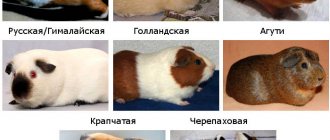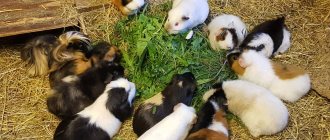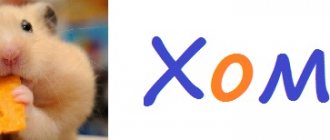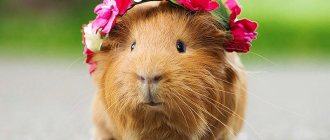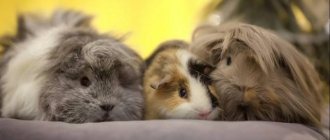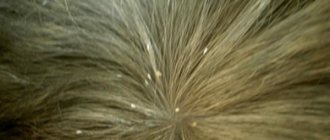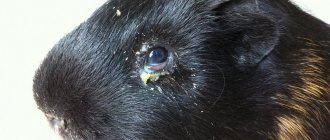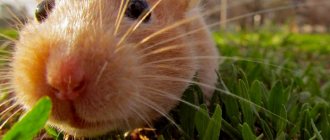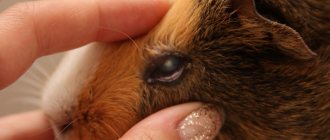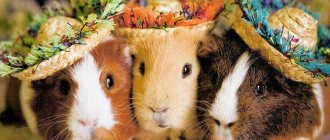- home
- Guinea pig
- Guinea pig breeds
02/18/2019 As soon as guinea pigs began to gain popularity, many breeds of these animals were bred by breeders. From the most exotic, bald or long-haired, to the very familiar ones, differing only in their unusual colors. One of these was the Californian breed, the youngest of the guinea pig varieties to emerge.
Pigs native to California
The California Shorthair breed appeared recently - about twenty years ago, and is one of the youngest breeds today.
The animals were bred in Peru, from where they came to the USA and there they received a second birth and a large number of colors. California-colored animals arrived in Europe in 2012. The first male introduced to the continent was Macho Picchu. It is his descendants that are still used in many European nurseries. The Californians arrived in Russia in November 2013.
Descendant of Macho Picchu - champion Edelweiss
Nutrition
The diet of the California variety of porpoises consists mainly of fish. In the process of studying these mammals, scientists recorded 17 species of fish that the mammal feeds on, and all of them belong to the bottom ones - those that live on the bottom of the sea in the areas of the animal’s geographical distribution. In addition to fish, the vaquita's daily menu may include shellfish, squid and shrimp. It is helped to obtain food in the water column by its teeth, which in their appearance resemble small spatulas, of which there can be from 34 to 42 pairs. While diving for prey, animals are able to linger under the water for up to 5 minutes.
Appearance
California pigs have a recognizable appearance:
- massive physique,
- broad shoulders,
- stocky and round body,
- heavy and rather large head,
- a thick nose and a pronounced hump,
- expressive and bulging eyes. Eye color depends on the color
- round and long ears.
The average weight of females is up to a kilogram, males are slightly heavier - one and a half kilograms. The animal's legs are short, with four toes on the back and three on the front.
Like all other breeds, California pigs have very developed incisors, so the constant presence of roughage and woody twigs in the cages is recommended.
External differences from dolphins
Some people confuse the species of these mammals with small dolphins, because these animals are similar in appearance and skeletal structure. Although vaquitas have a fish-like body with horizontal tail fins, their chest fins are shorter, located closer to the head and similar to modified forelimbs.
Some zoologists even attribute them to the dolphin family, but in fact there are no family ties between the vaquita and dolphins.
Also, unlike the dolphin community, all known varieties of vaquitas are much smaller in size, their skulls are more blunt in shape, their beaks lack the characteristic elongation of a dolphin, and some species may even lack a dorsal fin. Also, their teeth are not conical, but flattened.
Features of color
Light-colored babies can be born almost white, and the skin takes on its adult color within eight to twelve weeks. The intensity of the color depends on the environmental conditions - in a colder room the pigs become brighter, but in a warm room the color may not appear at all. The gene that affects color is dominant, which means that in a family from a Californian pig and a regular pig there is a chance to get babies with the desired color. This feature of gene transfer is also used by breeders of other breeds - silver, agouti, Swiss, alpine - to produce guinea pigs of mixed colors.
A purebred Californian guinea pig has dense and short fur, the length of the hairs is no more than three centimeters. However, if the animal is a mixed breed and a California sire was used to convey the color, the coat may be longer or shorter.
There are several main colors of the Californian guinea pig:
- blue,
- cream,
- red-black,
- black and cream,
- chocolate,
- lilac,
- buffalo,
- dark chocolate,
- light chocolate.
Among them there can be both selfies - that is, pigs with a uniform and even shade of coat, without zonal darkening and inclusions of lighter hairs - and points. Point pigs are pigs that have darkening in the area of the eyes, ears, nose, and also with a darker color of the fur on their paws. Most often, the points have the same shade as the main coat, but they can differ. Cream and blue coats often show buffalo or chocolate points.
There are only 12 porpoises left on earth. Seeing her photo, people said goodbye ahead of schedule
A post about the Californian porpoise, also called the vaquita, has gone viral on Reddit. The animal is on the verge of extinction, and scientists are doing everything to preserve this species. But when users saw what the porpoise looked like, they wished the vaquita a speedy extinction.
The problem of the extinction of the Californian porpoise has hit the top on Reddit. Scientists call it the vaquita. In addition to being the smallest cetacean, she is also very cute.
The vaquita's eyes are surrounded by a neat black ring, and the same dark spots form a kind of smile around her mouth.
The vaquita does not win in size among porpoises. Its maximum height is one and a half meters, and its weight can reach 50 kilograms. In the water, this smiling creature looks something like this.
According to the World Wildlife Fund (WWF), due to human carelessness and poaching, there were only 30 individuals of this porpoise left in the world in 2022.
In early March 2022, the director of the international anti-wildlife trade organization Elephant Action League told Monagbay that there were no more than 12 vaquitas left on earth. All of them live near the shores of the Gulf of California and often avoid people.
Typically, vaquitas only come to the surface for a second to take a breath of air. Local fishermen are not interested in them, but chance decides everything - vaquitas often end up in nets set by people to catch shrimp and the rare totoaba fish. Mexican laws prohibit fishermen from setting nets in the Gulf of California, but the ban does not stop poachers and smugglers.
According to the New York Times, scientists have been trying to breed the vaquita in captivity. But, as it turns out, porpoises are very shy creatures. The captured individual was unable to cope with the stress of the forced displacement and died.
A Reddit user with the nickname p_please_respond, in his post dedicated to vaquitas, recalled that in 2022 there are only 12 individuals of this species left on earth.
This animal is called a vaquita. They live in the Gulf of California and there are only 12 of them left.
However, redditors did not appreciate the author’s concern. Many of them, upon seeing the vaquita, began to worry not about the animal, but about their personal well-being.
Put this thing back where it came from and help me!
Yeah, nice to meet you.
Bye bye.
Users suggested that the vaquita from the photo was the same individual that scientists caught to test the possibility of raising California porpoises in captivity.
Unfortunately, this vaquita may be the one that passed away when it was captured for research. The vaquita porpoise has never been successfully captured and placed under human observation.
Redditors, a little more moved by the topic of the extinction of the species, shared new information. If they are right, then scientists' attempts to stop the extinction of porpoises may remain in vain.
Unfortunately, the species will become extinct. No human intervention will stop the decline in the population of these amazing creatures. In biology and genetics this is called a bottleneck. The idea is that when the gene pool becomes too small, you cannot restore the species through crossbreeding.
Meanwhile, the vaquita even has its own day. Activists consider July 7 to be Save the Vaquita Day. Events held on this day in different countries of the world were designed to draw public attention to the plight of these porpoises. But given the rate of population decline, vaquitas may not live to see another day dedicated to their protection.
Meanwhile, it’s not just the vaquita that is in imminent danger of extinction. The Elusor macrurus punk turtle could be the next unique animal you won't find in the wild. And all because of the green algae that grows directly on the head and shell of the turtle, making it look like a real rebel and arousing the interest of aquarists.
The dog Salty from Australia makes no less an impression on social media users than the vaquita. The dog not only has his own intagram, but also teeth that are very similar to human ones.
California Guinea Pig Cost
The cost of a purebred Californian guinea pig is quite high. Depending on the color, a two-month-old male can cost up to twenty-five thousand rubles. The female is cheaper - about ten thousand. The difference is explained by the fact that males are often used on gilts of other breeds.
The female is also capable of transmitting the Californian color, but the percentage of Californian cubs in her litter with any other male will be much lower.
Prices for crossbred children usually start from six thousand rubles. The exception is rare gene combinations. For example, when children are obtained from a Californian male and a female Swiss Dalmatian or silver agouti. If the baby has Californian colors, especially with characteristic points, then its price can reach thirty thousand or more.
Reproduction
The offspring of the Californian porpoise appears when the weather warms up with the arrival of the spring period or at the beginning of the summer season. As scientists suggest (due to the lack of knowledge about these mammals, there is no exact information about this), pregnancy of a mammal lasts on average 10-11 months. For one litter, the Californian porpoise usually brings 1 cub, in rare cases - 2. The initial length of the baby is about 0.6-0.7 m, but scientists have not determined the exact weight with which the baby is born. For four to six months, the female vaquita feeds her baby with milk.
Porpoises
Porpoises are one of the smallest marine mammals. They belong to the family Phocoenidae, one of ten families of the suborder Odontoceti (toothed whales). These animals are close relatives of dolphins of the Delphinidae family. Both diverged from a common ancestor about 10 million years ago, but since then they have developed significant differences in many aspects of biology.
The name "porpoise" comes from the Latin words "porcus" meaning "pig" and "piscus" meaning "fish".
Interesting facts about the rodent:
- Guinea pigs were domesticated in the 5th millennium BC. e. Andean tribes of South America (today Colombia, Ecuador, Peru and Bolivia) in order to eat rodent meat. During archaeological excavations in Peru and Ecuador, statues of guinea pigs were found dating back to 500 BC. e. before 500 AD e. They were worshiped by the Mochica people. Nowadays, in South America, guinea pigs continue to be eaten (in Peru, up to 65 million animals are used for this purpose per year). Guinea pig meat is similar in taste and nutritional value to rabbit and chicken meat, and is considered dietary.
- Selection work to develop guinea pig breeds lasted from 1200 to 1532. And during the period of the Great Geographical Discoveries, traders from Spain, Holland and England brought pigs to Europe, where they gained popularity as pets at royal courts (for example, Queen Elizabeth I of England).
Article rating:
California breed of guinea pig Link to main publication
Related publications
- Name options for guinea pigs
History of the distribution of the animal
This breed was developed relatively recently. They were first spotted on a farm in Peru in 2008. Peruvians cannot say exactly when this variety appeared, but it happened about 20 years ago. Previously, it was believed that a color like this animal did not exist in nature.
In 2012, the Californian breed was brought to Germany by Christian Koch. The first male introduced to Europe was the Macho Picchu, from which many of the continent's modern pets are descended. In Russia, these animals first appeared in January 2014.
CALIFORNIA pros and cons
A new pattern for Russia of smooth-haired (and not only) guinea pigs, the California Point (Siamese) has become very popular due to the unusualness and great attractiveness of guinea pigs, similar to the California rabbit or Siamese cat. In pigs with this pattern, the skin color on the ears, paws, nose and fur around the nose becomes black, brown or purple, different from the main coat color. The dark areas are called “points”. Moreover, this pattern does not appear immediately from the beginning of the birth of animals. At first, the babies are no different from their relatives and are born with pink ears, feet and nose. Then, within a few days after birth (3-5, sometimes up to 30 with chocolate or lilac points), the pattern begins to appear and “paint” dark. The color of the fur around the nose appears even later, after 30-160 days. The brightness of the pattern depends on the genetics of the pig and the temperature at which the pig is kept. At lower temperatures (at 16-20 degrees), the pattern appears more clearly and will be much darker than that of pigs kept in a dry, hot climate.
For example: birth of a California Point pig 1 day:
California Point Day 5:
Source
California breed standard
California Breed Standard¶
From: Peaks - February 19, 2015 1:50 pm
CALIFORNIA Head, Eyes, Ears 10
The head should be short and wide, the profile should be formed by smooth curves.
Muzzle: Broad and smoothly rounded near the nostrils. Eyes: Large, bright and protruding, set far apart. Ears: Large and drooping, set well spaced apart. Body, Shape 10
Should be short, broad, well built, with very high, broad shoulders.
Must be healthy, in good physical shape, with large muscle mass. Size should be appropriate for age Figure 50
Consist of even, clearly defined dark spots on the face, ears and paws, with a clear border separating them from the main color of the body. (in which) Spot (25) Should be visible, wide end at the nostrils, ideally pear-shaped, rising smoothly between the eyes; clearly defined, strongly colored black or rich milk chocolate. Ears (5) Should be intensely colored black or rich milk chocolate, down to the base. Feet (20) Should be a uniform, intense color of black or rich milk chocolate, clearly demarcated, with the color distributed well over the legs, including the claws and paw pads.
